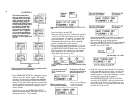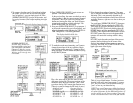
ALGORITHM
#
I
These bracketed numbers
show you where the on/off
switching is done in the algo-
rithm. Operators can be dis-
abled (turned Off) using the
[OPERATOR ON/OFF] buttons,
but they remain Off only while
programming. Stored voices
have all operators On. The
reason you have heard only
Operator 1 in the "intialized"
voice even though all Opera-
tors are On, is that all output
levels are set to 0, except
Operator 1, whose output level
is
at 99.
And watch the current operator change: 1-2-3-4-5-6-1-2-
3 etc.
Leave the display showing OP3.
Since you're only going to be working with operators
1 and 2 at first, this can be annoying if you have to
move from operator 2 to operator 1; it requires that
you cycle through 3, 4, 5 and 6 to get back to 1. In
subsequent steps we show you how to speed the
process of selecting the current operator.
2. Since you will not yet be using operators 3, 4, 5 or 6,
you can turn them OFF by pressing the correspond-
ing [OPERATOR ON/OFF] buttons once. You won't
hear any change in the sound as you play because
those operators are not contributing to the sound
(their output levels are set to zero).
Press each of these buttons once and watch the display
change
As you can see, the DX7 automatically performs the
OPERATOR SELECT function if you turn OFF an
operator that is set as the current operator.
3. Now press [OPERATOR SELECT] several times and
observe that the display only moves between OP1
and OP2. Leave it set to OP2.
34
The heavy line shows which operators contribute to the
sound: Operator 1 alone in this case
1. Press [OPERATOR SELECT] to change the operator
which is set as the "current" operator. The current
operator is the one whose parameters are displayed,
and which you can program with the DATA ENTRY
controls. Even when several operators are turned ON
and are contributing to the sound, only one at a time
can be adjusted or examined by selecting it as the
current operator.
Each time you press the [OPERATOR SELECT]
button, the current operator increments by one, and
then jumps from 6 to 1 and continues.
As soon as you turn off
OP 3, it cannot be ad-
justed
So the current OP
#
auto-
matically goes to the next
operator which is On
When you then turn off
OP4, it cannot be adjusted
So the current OP
#
goes
to the next operator
which is turned On
4. In the last 3 steps you have pressed a lot of buttons,
but if you bothered to play any notes, you will have
noticed that the sound did not change. In order to
modulate operator 1 and create harmonics, you have
to bring up the output level of operator 2.
Press [OPERATOR-OUTPUT LEVEL] and then
move the [DATA ENTRY] slider up to increase the
level from 0 to 99. Play the note repeatedly as you
increase the settings. You probably won't hear much
until the level is up near 50.


















